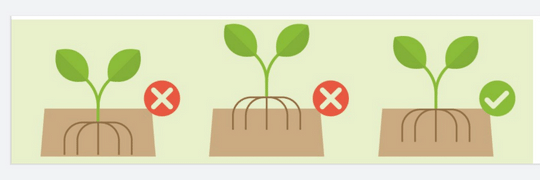We are glad that you have decided to take home one of our edible rose bushes “Taste Of Love®.
Now it is necessary that you continue with our efforts and take care of it properly, to achieve the beauty that these roses can offer you as soon as possible and to be able to taste their appetising and fragrant flowers.
Get ready, we’re starting
PLANTING AND FERTILISATION:
(a) POTTER:
Choose a container with a 30 cm minimum diameter. Use good quality peat mixed with a slow release fertiliser for 3 to 6 months. If you do not choose a slow release fertiliser, you should fertilise in the growing season (April to September) every 2 weeks with a liquid fertiliser in the irrigation water. At the time of repotting the rose bush, do it at the same height as in the original pot, because planting too deep will cause premature death of the rose bush due to root asphyxia. A too shallow transplanting will cause dehydration damage to the root system. Water deeply to stabilise your rose bush.
Roses need a full sun site and can tolerate semi-shade, but will not grow in full shade.
b) GARDEN:
Choose a sunny planting place. Dig a 40 cm x 40 cm hole. Mix the soil with some good peat or compost. Add a slow-release fertiliser. Just as for transplanting in pots and for the same reasons, do it at the same height as the original pot. Water deeply to stabilise your rose bush. If you do not choose a slow-release fertiliser at the time of planting, you should fertilise in the growing season (April to September) every 2 weeks with a liquid fertiliser in the irrigation water.

IRRIGATION AND PRUNING
a) IRRIGATION:
*Roses in pots: They need continuous irrigation throughout the year. From spring to autumn, check the humidity of the substrate daily. The substrate should be moist to feel, but not waterlogged.
*Soil-planted roses: Require more deep irrigation during the first year of planting. These irrigations allow the roses to form a deep and abundant root system, which benefits the development of plants. In the following years they need less water than roses in pots.
b) PRUNING:
*Maintenance pruning (May to October): Maintenance pruning involves the correct cutting of branches to obtain the maximum number of flowers in the months when the rose bush is in vegetation. Once the flowers on a stem have passed, the stem should be pruned below the first or second leaf composed of five leaflets. This action activates the development of a new flower bud on the same branch, forming this branch into a new stem that will result in a flower. If maintenance pruning is carried out too high, a blind stem will form which will not result in a flower. Pruning should be continuous during the late spring, summer and early autumn months.
*Renovation pruning (winter): Renovation pruning is carried out once a year in the winter months when the rose bush is at a vegetative standstill. All branches of the rose bush are cut back to one third of their size. Stems that are thinner than a pencil shall be completely discarded. It is a pruning that gives new vitality to the rose bush and will make the plant much more flowering in the following spring.
We hope that all these recommendations will lead you to production success.
Stay tuned to our social networks as we will continue to help you with more tips to enjoy our shared passion for plants.
A. Mónica Martínez




